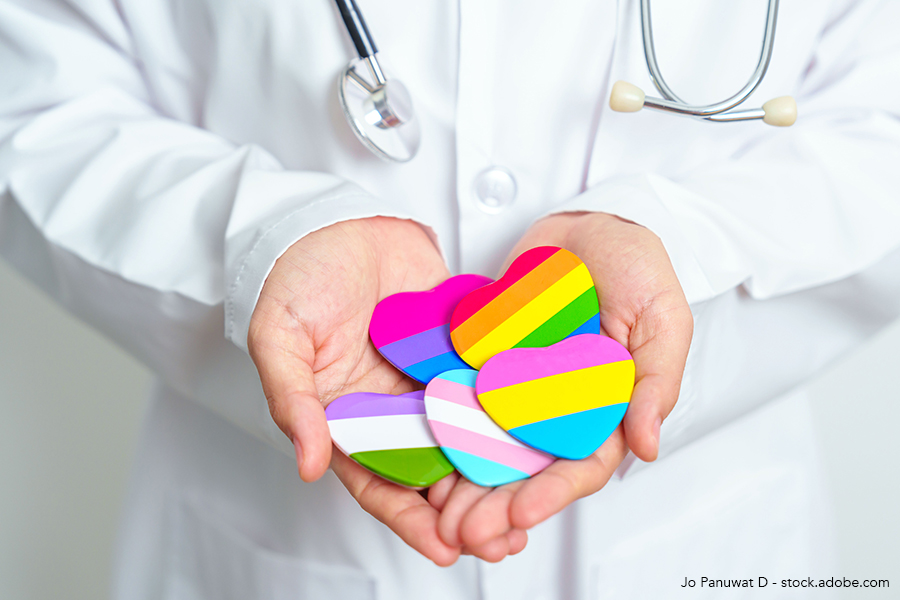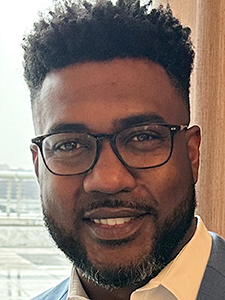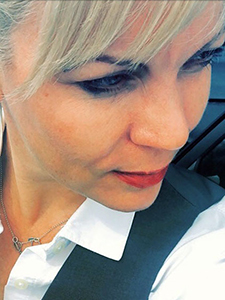 Hospitalists who are part of the lesbian, gay, bisexual, transgender, queer, intersex, asexual, and other (LGBTQIA+) community have had an array of experiences, both in medical school and professionally, related to their personal identity. While many see real progress and describe their workplace as welcoming, these same hospitalists have had previous struggles with fitting in. Some find themselves still fielding unusual comments from colleagues, which they dodge with humor or sincere curiosity.
Hospitalists who are part of the lesbian, gay, bisexual, transgender, queer, intersex, asexual, and other (LGBTQIA+) community have had an array of experiences, both in medical school and professionally, related to their personal identity. While many see real progress and describe their workplace as welcoming, these same hospitalists have had previous struggles with fitting in. Some find themselves still fielding unusual comments from colleagues, which they dodge with humor or sincere curiosity.
The Hospitalist recently spoke with five hospitalists who shared more about their challenges and opportunities as members of the LGBTQIA+ community.

Dr. Chua
Ian Chua, MD, (he/him) is a pediatric hospitalist, assistant professor of pediatrics at Stanford Children’s Health in Palo Alto, Calif. and Children’s National Medical Center in Washington, D.C., and co-chair of the American Academy of Pediatrics section on hospital medicine, LGBTQIA subcommittee.
Dr. Chua sees himself in an interesting role, being gay and an Asian immigrant (originally from the Philippines). “Because of the collective challenges that you carry from being an immigrant and in the gay community, it makes you more receptive and sensitive to others in terms of how to get them to open up more,” said Dr. Chua, who spends his time about 50/50 between his two hospitals on the west and east coasts.
With patients, being gay sometimes provides a safe area where they can share themselves more, whether it’s a teenager who’s struggling with their sexuality or someone who just feels they are more fluid.
He feels that he needs to be mindful of how open he is about himself among colleagues or patients. “That’s more pronounced in the current political climate. You can tell if someone is giving you a look because you’re wearing a rainbow pin,” he said.
Although Dr. Chua practices in two more liberal-leaning areas, he still sees a spectrum of acceptance toward being gay. “Some are more heteronormative, even if they are accepting, meaning they are more accepting if you want to be married and have children like they do,” he said.
Dr. Chua also has at times noticed some differences in interactions with nurses or other hospital workers from his native country. They may want to set him up with a niece or other family member; when they find out he’s gay, their attitudes toward him change. “The Philippines is a very Catholic country, so there’s religion at play,” he said.
Dr. Chua didn’t come out until residency and aimed to find a place or places where he could feel truly comfortable. “It took me a while, but I got to the point of, why would I go somewhere that didn’t want to welcome me for me?” he said.

Dr. Crawford
Damian Crawford, MD, (he/him) is chief hospitalist with Frederick Memorial Hospital, and with Sound Physicians, both in Frederick, Md.
Dr. Crawford feels that being a gay man in his current part of the country—the Northeast, which tends to be more liberal—has not created challenges at work. He felt more trouble “finding my tribe” at medical school, also in Maryland, and then in residency in Boston. He says he didn’t know any other gay people for years and befriended a female friend during residency. The friend went on to finish school and get married. She invited Dr. Crawford to her wedding but said he couldn’t bring the man who was his partner at the time. “She said, ‘You people want all these special privileges,’” Dr. Crawford said.
What concerns Dr. Crawford about that incident is how physicians who may have biases can provide safety for someone with special health concerns, such as a person who is positive for human immunodeficiency virus (HIV) or who is transitioning genders.
The biggest challenge that Dr. Crawford faces is meeting someone at work and not knowing where they’ll fall in terms of acceptance toward the gay community. “There’s the additional navigation of knowing if this is a safe person or not. You become skilled at not talking about your personal life.”
Dr. Crawford recently had a coworker who didn’t know that he was gay. When Dr. Crawford casually mentioned being gay, the female coworker acted surprised and said she would have been open to dating him if he were straight. It was an awkward experience, he said.
Still, Dr. Crawford believes that people should be careful about always trying to find a struggle when discussing the LGBTQIA+ community. “We’ve come so far, and I think there’s a lot to celebrate now,” he said.

Dr. Jenkins
Ian Jenkins, MD, SFHM (he/him), is a hospitalist and chair of the patient safety committee at UCSD Hospital Medicine in San Diego and chair of the SHM Hospital Quality and Patient Safety Committee.
Dr. Jenkins says that he’s fortunate to be a hospitalist in California. “Generally speaking, our patients are treated with respect. We have great programs to recognize gender identity in the EMR [electronic medical records] and make our patients feel welcome,” he said. He also sometimes senses a subtle surprise or appreciation from LGBTQIA+ patients for how comfortable they feel talking to him.
Dr. Jenkins, who lives with two same-sex partners, has turned his story into a book, “Three Dads and a Baby: Adventures in Modern Parenting,” which has been well publicized and has been discussed by hospital leadership at their tier-five huddle. He also wrote about being gay and marriage equality in a short article that was published in the Annals of Internal Medicine.1
“Visibility turns queer from some shameful reveal to being left-handed, which has been a goal of mine since my undergrad days,” he said.
One challenge has been fighting a parental-leave policy that granted much more time to biological parents than to adoptive or surrogacy parents. He was able to apply some pressure to help change that policy.
Having more faculty members who are out can help bring positive attention to being gay, including in places around the U.S. that are undermining the worth of people who are LGBTQIA+, Dr. Jenkins says.
“Doctors are respected leaders, and we can help by consistently advocating for equity and inclusion for everyone,” he said.

Dr. Singh
Amteshwar Singh, MD, MEd, FACP (he/him) is associate program director for the hospital medicine fellowship with the division of hospital medicine at Johns Hopkins Bayview Medical Center in Baltimore.
Dr. Singh characterizes the work environment at Johns Hopkins and Sinai Hospital in Baltimore, where he worked previously, as rich in resources for those who are part of any marginalized community.
Among hospitalist peers, he says their work is very much supported and that people feel comfortable expressing their identity. He points to an affinity group that meets regularly to discuss initiatives, keep allies engaged, and celebrate events like Pride Month. There are even social clubs at Hopkins geared toward the LGBTQIA+ community.
Hopkins also offers Safe Zone training, which focuses on LGBTQIA+ awareness and ally training. The Safe Zone Project promotes “an environment where the lesbian, gay, bisexual, transgender, and queer community and their allies flourish intellectually, socially, and emotionally.”
Although Dr. Singh sees the overall atmosphere where he works as favorable for him as a gay man, he believes it would be useful for more hospitalists to do the Safe Zone training. This would help “so they know our history, where we came from, who we are, and how they can be strong allies.” This is important in light of other parts of the country where the climate and news headlines have been less favorable to those in the queer community.
Dr. Singh also would like to see traditional medical education expand to include current best practices in the care of the LGBTQIA+ community. He shares the example of learning about HIV post-exposure prophylaxis during medical school. “Now, we have come a long way in HIV prevention; we are, in fact, moving from oral to long-acting injectable pre-exposure prophylaxis, or PrEP,” he said. Transition options for transgender folks have remarkably progressed over the years, but learners’ exposure to such care is quite limited.
“These types of evidence-based clinical care specific to our community and perhaps the general community haven’t been as deeply engrained in the current medical education system,” Dr. Singh said. He has seen patients mislabeled as HIV-positive due to their use of PrEP. “If providers aren’t aware of current progress in LGBTQIA+ care, they could get mislabeled or mistreated, which can have negative outcomes,” he said.
Dr. Singh believes that with their heavy presence in undergraduate medical education and graduate medical education, hospitalists are perfectly situated to become more aware of these care advances and educate learners.

Dr. Wright
Masina Wright, DO (they/themme) is a locum tenens hospitalist in New Mexico.
Dr. Wright, who is embarking on a second career as a hospitalist, says they advocate frequently for queer health at work and while in medical school. This has included advocating for expanded pronoun use in the EMR. This advocacy led Dr. Wright, who uses the pronouns they/themme, to receive a diversity award from their residency class.
Dr. Wright describes themmeself as a nonbinary femme-presenting lesbian, which offers “straight passing privilege” in medicine culture. Dr. Wright will go out of the way to connect with patients who appear queer and come out at the bedside to establish a sense of possible community or trust. “By me being queer, there’s an extra layer of trust that can happen,” they said, pointing to the discomfort patients may feel from being sick and surrounded by strangers in a hospital environment where it feels unsafe to disclose their gender or sexuality.
With their location in New Mexico, acceptance of being queer is usually not an issue, Dr. Wright says. However, they have struggled with not feeling like themmeself at work. “It’s difficult to feel like it’s safe or okay with who I am outside of my private community,” Dr. Wright said. Over the past year, they have worked toward being at peace with their identity while practicing medicine. “If I’m taking care of a 97-year-old patient who can see me as his doctor and care provider, then the hospital administrator can see me for that as well,” Dr. Wright said.
Dr. Wright would like to see more pipelines for members of the queer community to get into medicine by advocating for increased diversity in medical school. “There are other minorities that need to be lifted up in medicine as well,” they said. “For people in academic medicine, bringing up more (members of the queer community) will help everyone.”
7 Tips for LGBTQIA+ Hospitalists
Finding your comfort zone on the job isn’t always easy. Here are seven tips for newer hospitalists who are gay, lesbian, or in the queer community.
1. Know the local environment both culturally and politically, Dr. Jenkins recommends. This is something to keep in mind when you’re searching for places to work. If the environment is favorable, you can likely feel comfortable being out. Otherwise, you’ll need to ask yourself if you’re ready to fight for change.
2. Go where you feel comfortable. “Don’t stay somewhere you don’t feel welcome,” Dr. Crawford said. “In 2023, there are other places where you can exist as yourself. Don’t be a martyr. Life is short.”
Dr. Jenkins shares the story of an interviewer in medical school who said he could use his student activism to keep him out of medical school after seeing that Dr. Jenkins was his school’s LGB Union president. “I said I’d much rather go to a better school where I was wanted and terminated the interview,” he said.
3. Be who you are, Dr. Wright advises. “We spend so much of our time at work that I feel it’s important to be in a work environment that appreciates me as I am,” Dr. Wright said. It will be easier to get through the task of helping sick people every day if you can be who you are versus leaving a big chunk of your heart at home, Dr. Wright explains. In their case, Dr. Wright has tattoos, a nose ring, and platinum hair. They have wondered if that would cause any controversy at work, especially at the local veterans’ hospital. If anything, they have received compliments for their style.
4. Take your time coming out. “For few people, coming out may be a snapshot in time. For many, it’s a slow process,” Dr. Singh said. Don’t feel pressured to come out before you’re ready. “Take your time and be comfortable before you feel you’re ready to be out,” he said. Take time to understand the outlook of life after coming out. Plan!
5. Think about how you want to respond to personal-life inquiries or biased comments. Dr. Singh points to situations at work where someone has assumed he has a wife and has asked about his “wife.” He’ll reflect on where the person is coming from and if he doesn’t perceive any malintent, he’ll respond with some humor. “These conversations come up,” he said.
You also may want to consider how to respond to inappropriate comments made about others, Dr. Jenkins says. One response he’s found helpful is, “That isn’t kind.” This helps, as most people don’t want to be perceived as mean. Another response he’s used when someone says something biased is, “Oh, I don’t get that one. Can you explain it?” That forces the person to backtrack or detail their bias, Dr. Jenkins says.
6. Seek out allies. Check in with your hospital’s human resource department or diversity, equity, and inclusion office to see what resources are available for those who are LGBTQIA+. If you don’t find an organization that would meet your needs, then check at your city or state level. “It doesn’t have to be in the hospitalist community. It could be at the physician level,” Dr. Singh said. “The whole idea of seeking out allies is to feel more empowered, safe, and comfortable.”
7. Remember that you’re not alone. By seeking out others within the LGBTQIA+ community and allies, you’ll feel the collective power and be able to help each other. “If you connect with the community—the stronger the community becomes—whether that’s joining your nearest LGBTQIA+ subcommittee or local gay sports league, then the more impact you’ll have on other hospitalists and beyond,” Dr. Chua said.
Vanessa Caceres is a medical writer in Bradenton, Fla.
Reference
- Jenkins IH. Reflections on marriage equality. Ann Intern Med. 2016;164(2):129-30.